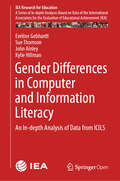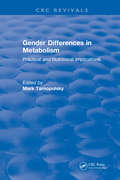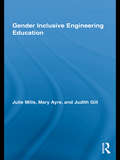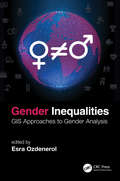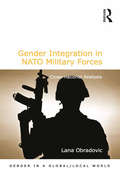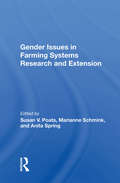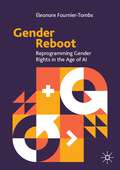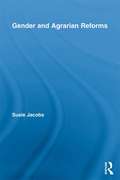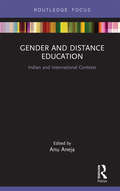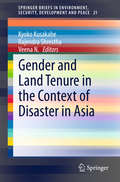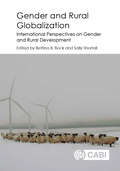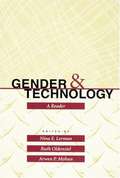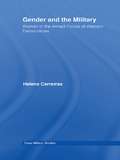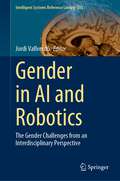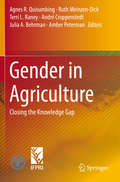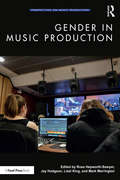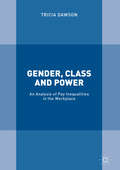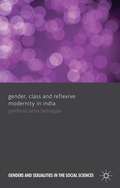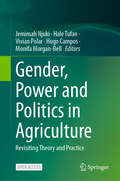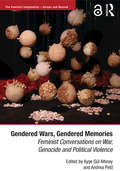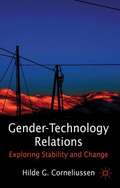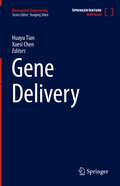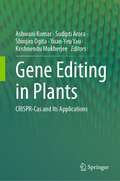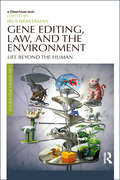- Table View
- List View
Gender Differences in Computer and Information Literacy: An In-depth Analysis of Data from ICILS (IEA Research for Education #8)
by John Ainley Eveline Gebhardt Sue Thomson Kylie HillmanThis open access book presents a systematic investigation into internationally comparable data gathered in ICILS 2013. It identifies differences in female and male students’ use of, perceptions about, and proficiency in using computer technologies. Teachers’ use of computers, and their perceptions regarding the benefits of computer use in education, are also analyzed by gender. When computer technology was first introduced in schools, there was a prevailing belief that information and communication technologies were ‘boys’ toys’; boys were assumed to have more positive attitudes toward using computer technologies. As computer technologies have become more established throughout societies, gender gaps in students’ computer and information literacy appear to be closing, although studies into gender differences remain sparse. The IEA’s International Computer and Information Literacy Study (ICILS) is designed to discover how well students are prepared for study, work, and life in the digital age. Despite popular beliefs, a critical finding of ICILS 2013 was that internationally girls tended to score more highly than boys, so why are girls still not entering technology-based careers to the same extent as boys? Readers will learn how male and female students differ in their computer literacy (both general and specialized) and use of computer technology, and how the perceptions held about those technologies vary by gender.
Gender Differences in Metabolism: Practical and Nutritional Implications
by Mark TarnopolskyGender Differences in Metabolism: Practical and Nutritional Implications is the first book to successfully integrate nutritional science, exercise physiology/medicine, and metabolism. This volume explores recent scientific evidence that male and female athletes exhibit different metabolic responses and, therefore, differ in their nutritional needs and advice. Anyone interested in good health, exercise, and nutrition will find this book a valuable resource.
Gender Inclusive Engineering Education (Routledge Research in Education)
by Judith Gill Julie Mills Mary Elizabeth AyreWomen continue to comprise a small minority of students in engineering education and subsequent employment, despite the numerous initiatives over the past 25 years to attract and retain more women in engineering. This book demonstrates the ways in which traditional engineering education has not attracted, supported or retained female students and identifies the issues needing to be addressed in changing engineering education to become more gender inclusive. This innovative and much-needed work also addresses how faculty can incorporate inclusive curriculum within their courses and programs, and provides a range of exemplars of good practice in gender inclusive engineering education that will be immediately useful to faculty who teach engineering students.
Gender Inequalities: GIS Approaches to Gender Analysis
by Esra OzdenerolGender inequality is entrenched in the cultural, political, and market systems that operate at household, community, and national levels. Overarching global changes in access to markets, climatic conditions, and the availability of natural resources intensify disparities in income, assets, and power among genders. This book explains these gender dynamics at macro and micro levels through GIS and spatial analysis. Chapter 1 provides an overview of the current role of GIS in the context of gender inequalities, how it still exists globally despite substantial national and international measures that have been taken toward gender equality. It illustrates global and country-level maps of measures of gender inequalities, such as gender equality index, access to basic education, health and life expectancy, equality of economic opportunity, and political empowerment. The global case studies provided in the consequent chapters explore the world of gender inequalities and get directly involved with some of the GIS and mapping applications. Chapter 2 investigates how GIS can be adapted for the criminal justice response to domestic violence (DV) and to eliminate gender-based violence. Chapter 3 discusses applying GIS and spatial analysis to the prevalence and incidence mapping of intimate partner violence (IPV) and geospatial factors that influence help-seeking and resource availability. Chapter 4 discusses the spatial disparity of gender-representation across industry types in the United States. Chapter 5 explores the social and environmental injustice experienced by female migrant workers at Guiyu town, China, in the context of both environmental pollution and governance. Chapter 6 presents a social vulnerability index to identify spatial patterns of social vulnerability and gender inequalities among Mexican households. Chapter 7 presents the United States’ opioid crisis over the past two decades and analysis of mortality by gender, race, age, and urbanicity. Chapter 8 discusses the commitment to "leave no one behind" as the heart of the 2030 Agenda for Sustainable Development and identifies inequalities among women and girls by mapping multiple deprivations in Pakistan. Chapter 9 discusses the long-standing challenges in establishing gender parity in the transportation workforce in the United States. Chapter 10 presents a study that utilizes geospatial statistical tools and state-level admission data to examine gender inequalities in higher-education enrollment in Nigeria and investigates the key factors on enrollment. This book fosters engagement with the newest mapping and GIS application in contemporary issues regarding gender inequalities and nurtures recognition of how institutional global, everyday, and intimate spaces are inherently gendered, classed, raced, and sexualized. It demonstrates the spatiality of the politics of gender difference, and the contributions of GIS and spatial analysis to the struggles for equality and social justice. A unique work that Lays out a step-by-step approach to identify relevant GIS applications, spatial methods, data collection, and mapping techniques for gender inequalities research Has a strong international and global perspective. The author is well-informed in global perspectives Investigates the patterns/processes and indicators driving gender inequality at various temporal scales and at comparably detailed resolutions Illustrates finer-scale case studies, appropriate for local programs and interventions, as well as global scale studies contributing to international and national-level policy discussions on gender inequality Since gender inequality is a research area that is very wide and with strands into many academic traditions, this book is aimed at different and diverse academics/research. It is written for geographers, public health practitioners, sociologists, epidemiologists, criminologists, politicians, economists, environmentalists, G
Gender Integration in NATO Military Forces: Cross-national Analysis (Gender in a Global/Local World)
by Lana ObradovicNumerous states have passed gender integration legislation permanently admitting women into their military forces. As a result, states have dramatically increased women’s numbers, and improved gender equality by removing a number of restrictions. Yet despite changes and initiatives on both domestic and international levels to integrate gender perspectives into the military, not all states have improved to the same extent. Some have successfully promoted gender integration in the ranks by erasing all forms of discrimination, but others continue to impede it by setting limitations on equal access to careers, combat, and ranks. Why do states abandon their policies of exclusion and promote gender integration in a way that women’s military participation becomes an integral part of military force? By examining twenty-four NATO member states, this book argues that civilian policymakers and military leadership no longer surrender to parochial gendered division of the roles, but rather support integration to meet the recruitment numbers due to military modernization, professionalization and technological advancements. Moreover, it proposes that increased pressure by the United Nations to integrate gender into security and NATO seeking standardization and consistency on the international level, and women’s movements on the domestic level, are contributing to greater gender integration in the military.
Gender Issues In Farming Systems Research And Extension
by Marianne Schmink Susan V. Poats Anita SpringThis book is the product of an international conference hosted by the Women in Agricultural Development (WIAD) Program at the University of Florida in 1986. The purpose of WIAD program is to promote an understanding of gender and its relevance for agricultural development processes.
Gender Reboot: Reprogramming Gender Rights in the Age of AI
by Eleonore Fournier-TombsThis book explores gender norms and women’s rights in the age of AI. The author examines how gender dynamics have evolved in the spheres of work, self-image and safety, and education, and how these might be reflected in current challenges in AI development. The book also explores opportunities in AI to address issues facing women, and how we might harness current technological developments for gender equality. Taking a narrative tone, the book is interwoven with stories and a reflection on the raising young children during the COVID-19 pandemic. It includes both expert and personal interviews to create a nuanced and multidimensional perspective on the state of women’s rights and what might be done to move forward.
Gender and Agrarian Reforms (Routledge International Studies of Women and Place)
by Susie JacobsThe redistribution of land has profound implications for women and for gender relations; however, gender issues have been marginalised from both theoretical and policy discussions of agrarian reform. This book presents an overview of gender and agrarian reform experiences globally. Jacobs highlights case studies from Latin America, Asia, Africa and eastern Europe and also compares agrarian and land reforms organised along collective lines as well as along individual household lines. This volume will be of interest to scholars in Geography, Women’s Studies, and Economics.
Gender and Distance Education: Indian and International Contexts
by Anu AnejaThis book investigates the intersection of gender and distance education from a feminist perspective and explores their contemporary innovative interfaces in Indian and international contexts. The key issues raised here include a re- investigation of the democratizing potential of distance education from a gendered perspective (especially in developing countries such as India), feminist pedagogical perspectives on the notion of transactional distance, the relationship between masculinity and gerontology from the perspective of non- traditional modes, and the interrelationships between gender and social media from a distance education perspective. As opposed to the conventional, physical classroom, the virtual classroom often occupies a de- privileged space in feminist pedagogical discussions, since it appears to align itself less easily with feminist praxes which encourage a free, intellectual exchange between teachers and students. By opening up various facets of the relationship between gender, distance education and feminist pedagogy, the book foregrounds the critical need to re- visit preconceived, unfavourable assumptions about this relationship and proposes mutually productive inter-linkages. It does so in the context of contemporary circumstances defined by the increasing use of virtual technology, the ongoing need for democratization of higher education and the constraints posed by consumerist trends. Lucid and topical, this Focus volume will be useful to scholars and researchers of higher education, open and distance education, feminist pedagogy, gender studies, feminism, masculinity, and women’s studies as well as practitioners and policymakers working in the education sector.
Gender and Land Tenure in the Context of Disaster in Asia
by Kyoko Kusakabe Rajendra Shrestha Veena N.This book explores an interdisciplinary field at the intersection of gender and development studies, disaster and land tenure policy. It is well known that women generally have weaker claims to land. But how does that translate to increased vulnerability during disaster? Using case studies from Asia, this book argues that land tenure is a key factor in mitigating the impact of disasters on women. The scale and frequency of disasters have been increasing in recent decades due to human impact on the landscape and climate. Unsustainable farming and land management systems have increased environmental risks and social vulnerabilities. However, around the world the costs of disasters are disproportionately borne by women, due largely to their reduced mobility and lack of control over assets. In post-disaster settings, women's vulnerabilities increase due to gendered rescue and rehabilitation practices. As such, a gendered approach to land rights is critical to disaster preparedness and recovery.
Gender and Rural Globalization: International Perspectives on Gender and Rural Development
by Anne Cassidy Monika Agarwal Mark Riley Margaret Alston Janet Momsen Wendy Harcourt Sally Shortall Heather Sangster Jessica Duncan Berit Brandth Angela Calvo Megan Canning Francesca Alice Centrone Majda Cernic Istenic Chrysanthi Charatsari Elisabeth Garner Donatella Greco Marit S. Haugen Susie Jacobs Lori Ann McVay Ilona Matysiak Peter Mollinga Angela Mosso Caoimhe Ni Dhonaill Nargiza Nizamedinkhodjayeva Carolyn Sachs Susanne Stenbacka Margreet van der Burg Chiara ZanettiThis book explores how rural gender relations are changing in a globalising world that fundamentally impacts on the structure of agricultural life in rural areas and urban-rural relations. It analyses the development of rural gender relations in specific places around the world and looks into the effects of the increasing connectivity and mobility of people across places. The themes covered are: gender and mobility, gender and agriculture, Gender and rural politics, rurality and Gender identity and women and international development. Each theme has an overview of the state of the art in that specific thematic area and integrates the case-studies that follow.
Gender and Technology: A Reader
by Nina E. Lerman Ruth Oldenziel Arwen P. MohunFor most of human experience, certainly of late, the artifacts of technological civilization have become closely associated with gender, sometimes for physiological reasons but more often because of social and cultural factors, both obvious and obscure.
Gender and the Military: Women in the Armed Forces of Western Democracies (Cass Military Studies)
by Helena CarreirasThis is the first comparative, cross-national study of the participation of women in the armed forces of NATO countries. Along side an analysis of this key topic stands a critique of existing theoretical models and the proposal of a revised analytical framework. Unlike previous works this new study employs mixed-methodological research design combining quantitative and qualitative data - a large N-analysis based on general policies and statistical information concerning every country in the sample with more in-depth case-studies. This volume includes original empirical data regarding the presence of women in the armed forces of NATO countries, proposes an index of ‘gender inclusiveness’ and assesses the factors that affect women’s military roles. The book also presents two new key case studies – Portugal and the Netherlands - based on both documentary sources and in-depth interviews of both men and women officers in the two countries. This book will be of great interest to all students and scholars of strategic studies, gender and women studies and military history.
Gender in AI and Robotics: The Gender Challenges from an Interdisciplinary Perspective (Intelligent Systems Reference Library #235)
by Jordi VallverdúWhy AI does not include gender in its agenda? The role of gender in AI, both as part of the community of agents creating such technologies, as well as part of the contents processed by such technologies is, by far, conflictive. Women have been, again, obliterated by this fundamental revolution of our century. Highly innovative and the first step in a series of future studies in this field, this book covers several voices, topics, and perspectives that allow the reader to understand the necessity to include into the AI research agenda such points of view and also to attract more women to this field. The multi-disciplinarity of the contributors, which uses plain language to show the current situation in this field, is a fundamental aspect of the value of this book. Any reader with a genuine interest in the present and future of AI should read it.
Gender in Agriculture
by Agnes R. Quisumbing Ruth Meinzen-Dick Terri L. Raney André Croppenstedt Julia A. Behrman Amber PetermanThe Food and Agriculture Organization of the United Nations (FAO) produced a 2011 report on women in agriculture with a clear and urgent message: agriculture underperforms because half of all farmers--women--lack equal access to the resources and opportunities they need to be more productive. This book builds on the report's conclusions by providing, for a non-specialist audience, a compendium of what we know now about gender gaps in agriculture.
Gender in Music Production (Perspectives on Music Production)
by Jay Hodgson Russ Hepworth-Sawyer Mark Marrington Liesl KingThe field of music production has for many years been regarded as male-dominated. Despite growing acknowledgement of this fact, and some evidence of diversification, it is clear that gender representation on the whole remains quite unbalanced. Gender in Music Production brings together industry leaders, practitioners, and academics to present and analyze the situation of gender within the wider context of music production as well as to propose potential directions for the future of the field. This much-anticipated volume explores a wide range of topics, covering historical and contextual perspectives on women in the industry, interviews, case studies, individual position pieces, as well as informed analysis of current challenges and opportunities for change. Ground-breaking in its synthesis of perspectives, Gender in Music Production offers a broadly considered and thought-provoking resource for professionals, students, and researchers working in the field of music production today.
Gender, Class and Power: An Analysis Of Pay Inequalities In The Workplace
by Tricia DawsonWith a particular focus on the British printing industry, this book tackles the ongoing issue of pay inequality and examines the challenges facing many women today. By analysing organisation processes within the workplace, the author considers the unequal allocation of power resources that generate and sustain women’s invisibility and argues that women’s power is often outflanked by that of their male colleagues. Written by a skilled academic with direct industry experience, this new book is an insightful read for those researching human resource management (HRM), women’s studies and diversity, as well as trade union officials and policy-makers.
Gender, Class and Reflexive Modernity in India (Genders and Sexualities in the Social Sciences)
by Jyothsna Latha BelliappaUsing in-depth interviews, this book explores women employed in the Indian IT industry and highlights the gender specific and culturally specific consequences of reflexive modernity in neo-liberal India.
Gender, Power and Politics in Agriculture: Revisiting Theory and Practice
by Hugo Campos Jemimah Njuki Vivian Polar Hale Ann Tufan Monifa Morgan-BellThis is a open access book. In the agriculture sector, the language of gender integration often ignores the politics and the power dynamics that are central to critical, and feminist, analysis of gender relations. This volume explores largely neglected topics such as power dynamics, masculinities, gendered social norms, feminist research practice, intersectionality, critical analysis of tools and more, that are fundamental to shifting the entrenched power dynamics and politics of gender research in agriculture. The purpose of this book is to reduce the gap existing between theory, methods, and practice of gender relations in agriculture and agricultural research. Through an in-depth analysis of current processes in agriculture and drawing on existing experiences in other sectors, it seeks to create pathways for learning, catalyzing change and positive impact on gender equity and social inclusion. This volume seeks to bring forth a change in how gender relations in agriculture are researched, practiced and taught.
Gendered Wars, Gendered Memories: Feminist Conversations on War, Genocide and Political Violence (The Feminist Imagination - Europe and Beyond)
by Ayşe Gül AltinayThe Introduction of this book is freely available as a downloadable Open Access PDF under a Creative Commons Attribution-Non Commercial-No Derivatives 4.0 license available at http://www.taylorfrancis.com/books/e/9781315584225 The twentieth century has been a century of wars, genocides and violent political conflict; a century of militarization and massive destruction. It has simultaneously been a century of feminist creativity and struggle worldwide, witnessing fundamental changes in the conceptions and everyday practices of gender and sexuality. What are some of the connections between these two seemingly disparate characteristics of the past century? And how do collective memories figure into these connections? Exploring the ways in which wars and their memories are gendered, this book contributes to the feminist search for new words and new methods in understanding the intricacies of war and memory. From the Italian and Spanish Civil Wars to military regimes in Turkey and Greece, from the Armenian genocide and the Holocaust to the wars in Abhazia, East Asia, Iraq, Afghanistan, former Yugoslavia, Israel and Palestine, the chapters in this book address a rare selection of contexts and geographies from a wide range of disciplinary perspectives. In recent years, feminist scholarship has fundamentally changed the ways in which pasts, particularly violent pasts, have been conceptualized and narrated. Discussing the participation of women in war, sexual violence in times of conflict, the use of visual and dramatic representations in memory research, and the creative challenges to research and writing posed by feminist scholarship, Gendered Wars, Gendered Memories will appeal to scholars working at the intersection of military/war, memory, and gender studies, seeking to chart this emerging territory with ’feminist curiosity’.
Gender–Technology Relations
by Hilde G. CorneliussenThrough empirical material as well as theoretical discussions, this book explores developments in gender-technology relations from the 1980s to today. The author draws on her long-lasting research in the field, providing insight in both historical and more recent discussions of gender in relation to computers and computing.
Gene Delivery (Biomaterial Engineering)
by Huayu Tian Xuesi ChenGene therapy has been regarded as a great potential for specific treatment of gene-related human diseases, such as cancer, genetic and epidemic diseases. Gene therapy refers to the biomedical technology that inserts normal or therapeutic exogenous genes into target cells to repair or replace defective genes in target cells, so as to achieve the purpose of treating diseases. Efficient gene delivery systems are the crucial roles for successful implementation of gene therapy. This book provides a platform for young scholars and students to systematically understand the preparation and characterization of the existing non-viral gene delivery systems, as well as providing a technology platform for clinical gene therapy
Gene Drives at Tipping Points: Precautionary Technology Assessment and Governance of New Approaches to Genetically Modify Animal and Plant Populations
by Arnim Von Gleich Winfried SchröderThis open access book reports on a pilot project aiming at collecting information on the socio-ecological risks that could arise in the event of an uncontrolled spread of genetically engineered organisms into the environment. The researchers will, for instance, be taking a closer look at genetically engineered oilseed rape, genetically engineered olive flies as well as plants and animals with so-called gene drives. The book mainly adresses researchers.
Gene Editing in Plants: CRISPR-Cas and Its Applications
by Ashwani Kumar Krishnendu Mukherjee Shinjiro Ogita Yuan-Yeu Yau Sudipti AroraThis book is a collection of information about applying CRISPR-Cas systems for genome editing in plants. The main focus of this book is to address the recent advances and future prospects of CRISPR-Cas technology in crops.Genome editing technology is important because it can be used to improve plant traits. The earlier genome-engineering tools, zinc finger nucleases (ZFNs), and TAL effector nucleases (TALENs) are complicated to design and not flexible. The novel genome editor, CRISPR-Cas systems, has advantages over ZFNs and TALENs. The advantages are simple and easy to design precision in targeting and efficiency. Due to its precision and simplicity, the CRISPR-Cas technology has rapidly become the most popular genome-editing platform in life-science fields. CRISPR-Cas technology has been used widely for human gene therapy to treat diseases and for plant breeding programs for crop improvement.This book is of interest and useful to genome-editing professionals, plant breeders, horticulturists, field-level extension workers, nurserymen, planters, ecologists, and valuable source of reference to the relevant researchers.
Gene Editing, Law, and the Environment: Life Beyond the Human (Law, Science and Society)
by Irus BravermanTechnologies like CRISPR and gene drives are ushering in a new era of genetic engineering, wherein the technical means to modify DNA are cheaper, faster, more accurate, more widely accessible, and with more far-reaching effects than ever before. These cutting-edge technologies raise legal, ethical, cultural, and ecological questions that are so broad and consequential for both human and other-than-human life that they can be difficult to grasp. What is clear, however, is that the power to directly alter not just a singular form of life but also the genetics of entire species and thus the composition of ecosystems is currently both inadequately regulated and undertheorized. In Gene Editing, Law, and the Environment, distinguished scholars from law, the life sciences, philosophy, environmental studies, science and technology studies, animal health, and religious studies examine what is at stake with these new biotechnologies for life and law, both human and beyond.
